
With the current COVID-19 pandemic deeply affecting museums across the world, many museum professionals at big and small museums alike are wondering how they can still connect and communicate with their audiences, each other, and the broader population. And for many, that answer is social media.
Whether you’re a social media manager or just looking for a way to leverage the power of social media for your museum, we’ve gathered examples of how museums are using Twitter, Instagram, Youtube, and other platforms in innovative ways.
We hope these examples inspire you! Let us know if you try any and be sure to share any other creative initiatives your museum is doing during the COVID-19 pandemic.
Involve your audience in museums’ advocacy efforts!
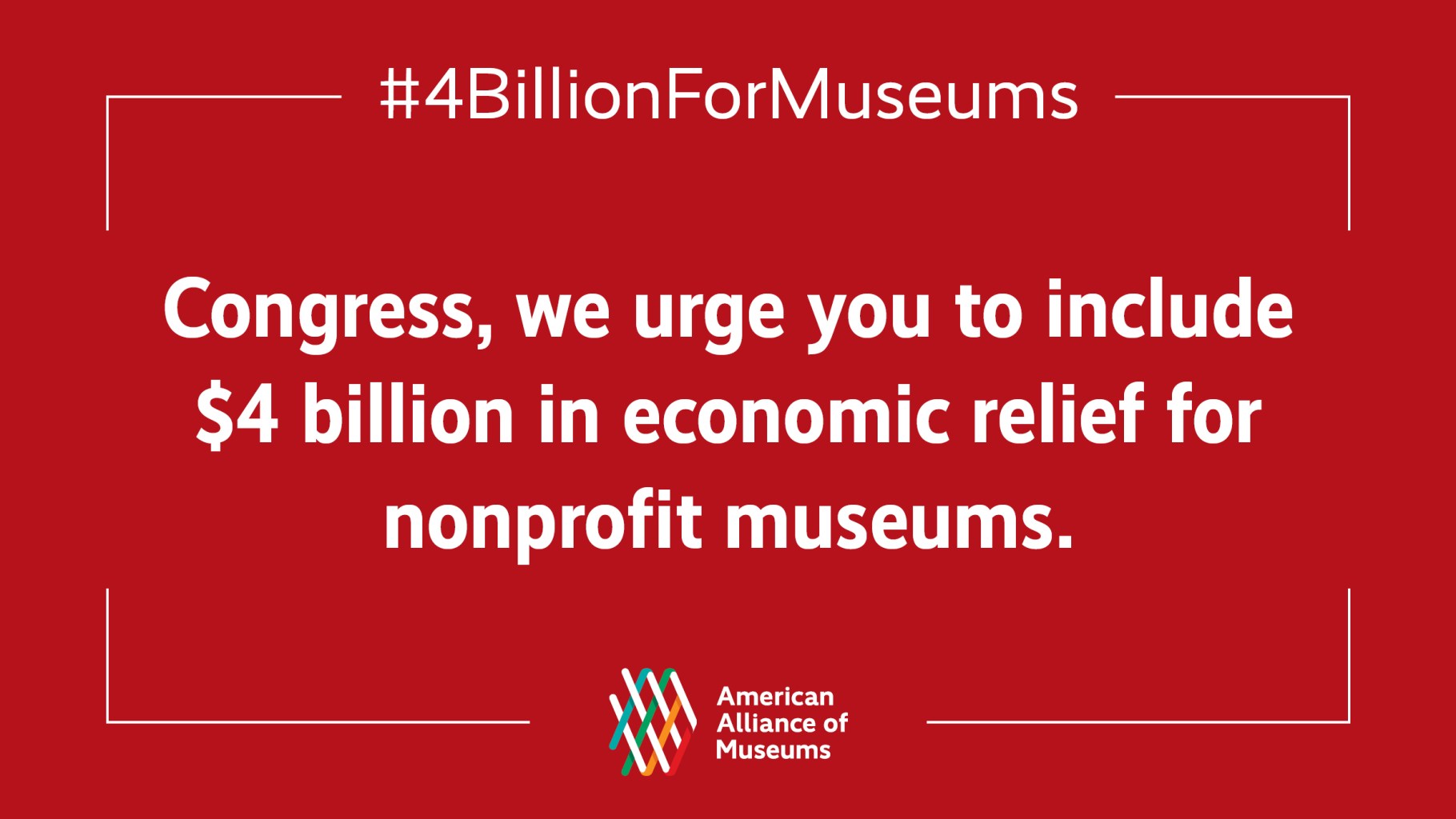
The Alliance is currently urging Congress to include nonprofit museums in economic relief. Not only can your museum be involved, but you can help your audience amplify their voice. Ask your audience to support your museum by writing to their elected officials using our easy-to-use template and by sharing why your museum is important to them using #4BillionForMuseums and #MuseumsAdvocacy on social media. We’ve created a few social graphics to help make sharing easier (with an option to include your museum’s logo). Download them here.
Create resources or posts that encourage audiences to learn and explore from home.
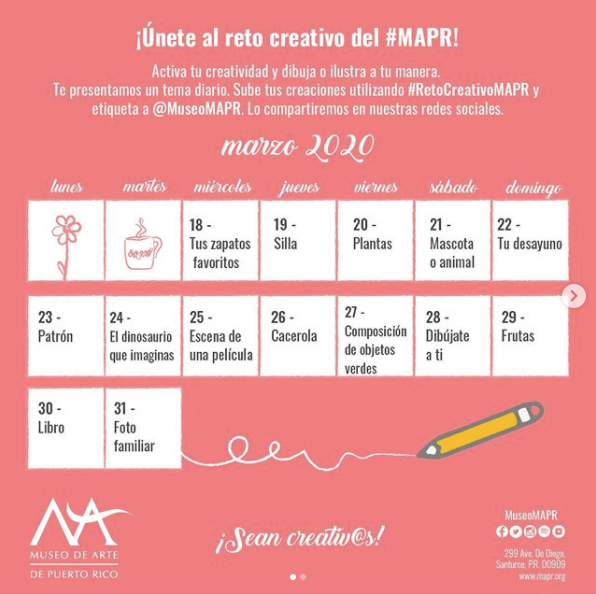
- Daily illustration challenge – El Museo de Arte de Puerto Rico
- Telling deeper stories about photographs, objects, and historical figures – National Museum of African American History and Culture.
- Sharing fun all-ages and particularly kid-friendly content while your visitor’s spaces are closed – Shedd Aquarium
- Get in character and have some fun with it! – The National Cowboy Museum’s series of posts from Tim the Security Guard. Follow along at: https://twitter.com/ncwhm
- Vancouver Art Gallery
In addition to these examples, Marilyn Hoffman of Museum Search & Reference suggests promoting things that can help bring revenue to your museum even if it’s temporarily closed, including early renewals of memberships, gift cards that can be used for later events, donations, and gift store and cafe purchases.
Proactively look for ways to form digital partnerships and join online conversations.
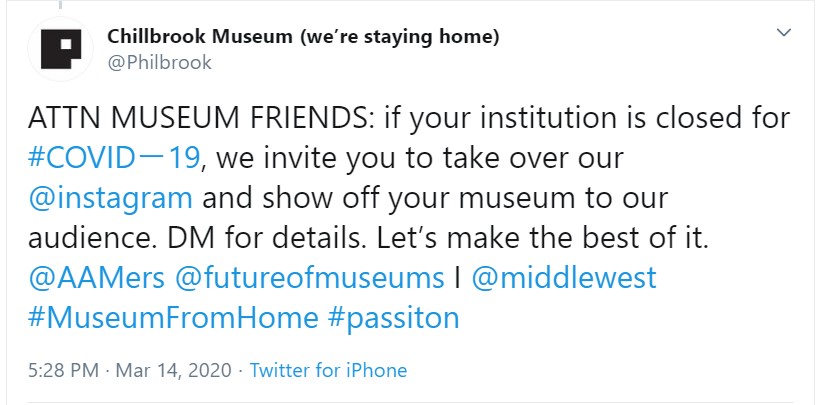
- Digital partnerships can mean direct collaboration through takeovers, swapping content, and tagging each other. For example, Philbrook offering up their Instagram account for takeovers.
- Make sure your museum is part of the conversation threads that are already happening in real-time.
Use images, video, and text to create virtual tours.
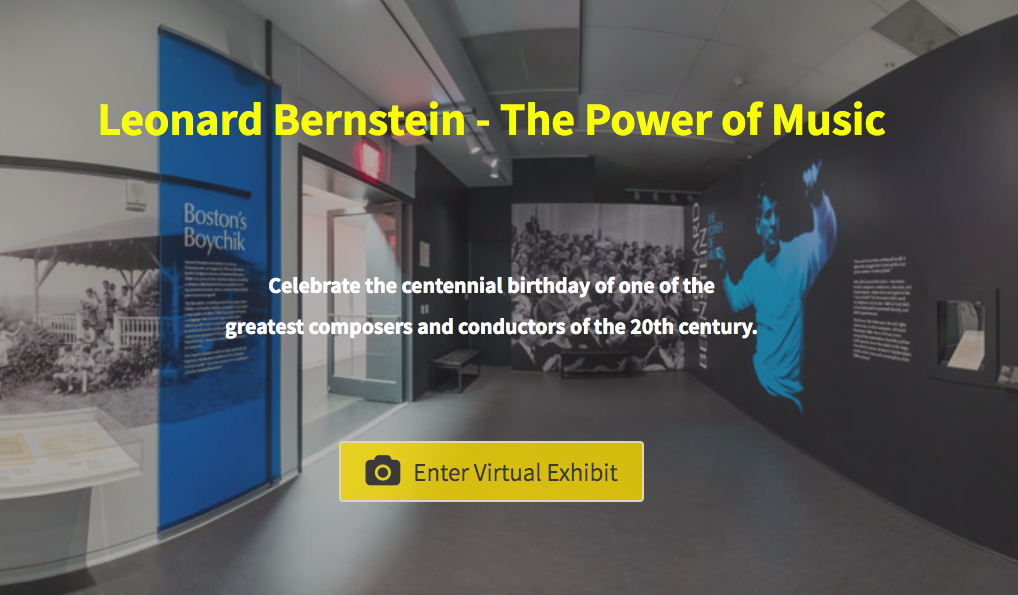
- Video tour – El Museo Nacional de Prado
- Multimedia tour – National Museum of American Jewish History. This tour is accessed through a website, but its format could be directly posted to social media as a thread or series of posts.
- Google Streetview 360-degree tour – Musée d’Orsay.
Repurpose older content or create unique content for new channels or features.
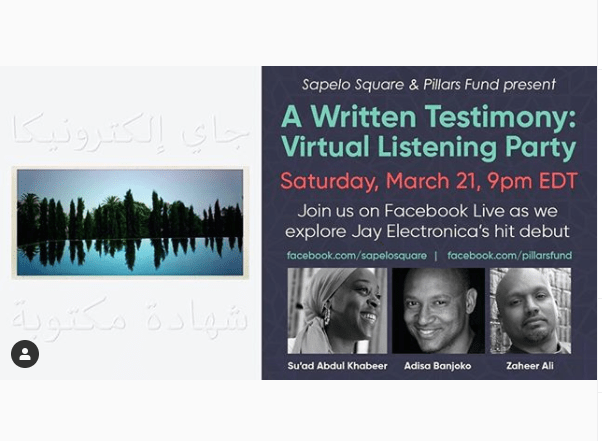
- Consider starting a TikTok
- Already have an Instagram or Facebook page? Start using the stories or IGTV features to hold informal webinars, republish clips from events, or do short interviews with staff.
- Instagram stories / IGTV
- Facebook Live
- If you have podcasts, consider where else you might post them to reach listeners:
Open up the conversation or content to a live format, like Facebook or Youtube Live.
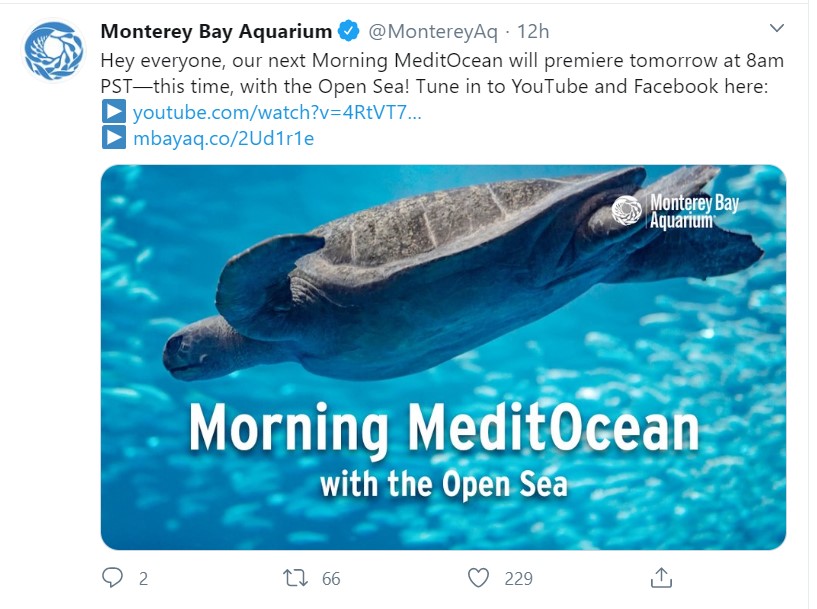
- Smithsonian Learning Lab Online Office Hours
- Monterey Bay Aquarium’s Morning MeditOcean (meditation)
- You can replicate the Live by hosting it on Zoom, and then you have the option to post to YouTube or Vimeo to share the content with those who missed it.
Host a tweetchat on a past or upcoming public programming topic.
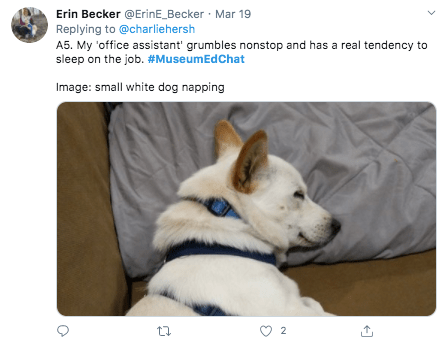
- #Museumedchat is a great example of a long-running and well-attended museum field tweet chat.
- Ohio Museum Association’s #OHMuseumChat is another great example.
Follow and contribute to hashtags to join the ongoing conversations.
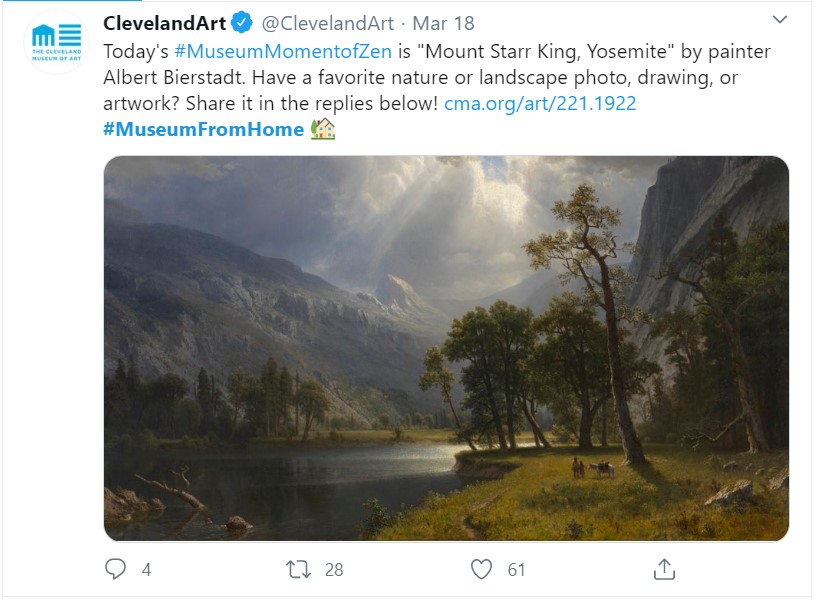
- Following #MuseumFromHome and #LaCulturaEnTuCasa, plus the more general #VisitFromHome, are a great way to discover curated content museums want you to see in place of visiting. Every Sunday, Seema Rao @artlust and Mar Dixon (@MarDixon) are running #MuseumGames for an interactive take on things to do, from crossword puzzles to jigsaw puzzles and more. Learn more in our blog post about how the Akron Art Museum uses these strategies.
- For content from visitors and museum admirers more generally, @CultureThemes organized #WhyILoveMusems on March 18th and #MuseumMomentofZen captures both museums and visitor’s favorite, peaceful moments.
- For teaching and education purposes, more generally you can follow these conversations that museums frequently take place in: #edchat #CovidCampus #edtech #LearninginPlace and #VirtualFieldTrip. For example, many of these digital project resources from the National Endowment for the Humanities (NEH) found in those conversations also include the work of museums.
- As Seema Rao (@artlust) has pointed out about #MuseSocial conversations, that these professionals have been tracking what nonvisitors do and how to get them engaged with museums for a while. While the work is not “business as usual” right now, it’s not completely outside the realm of the types of engagement going on in that conversation generally.
Create or join Facebook and LinkedIn groups for your favorite museums to connect with a community from a distance.
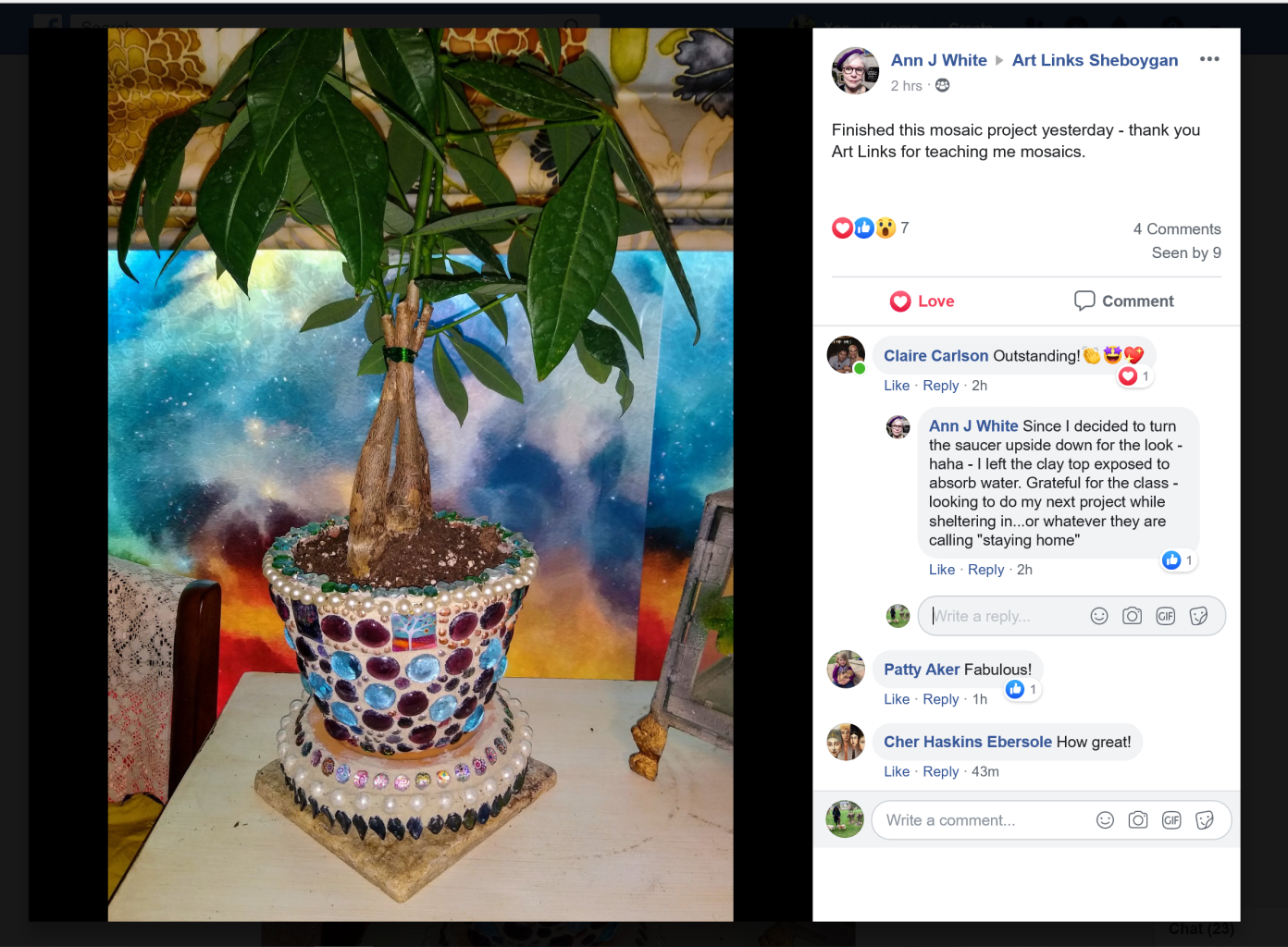
- Learn more about how Naples Botanical Garden and John Michael Kohler Arts Center have created communities for participants in their creative aging programs.
- For example, Harriet Beecher Stowe House created a Facebook group.




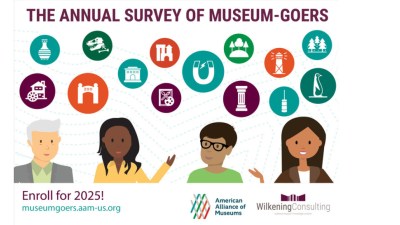
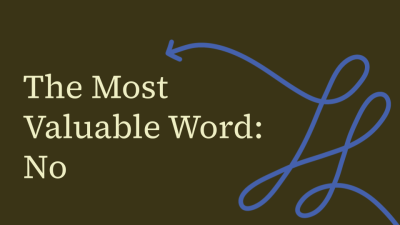


Comments